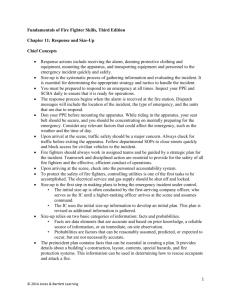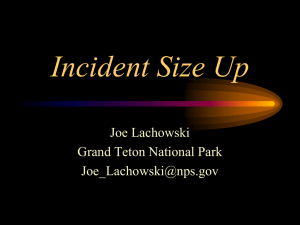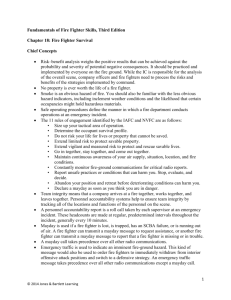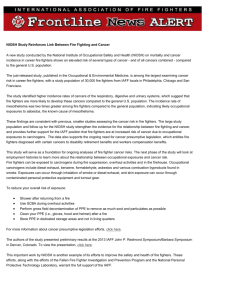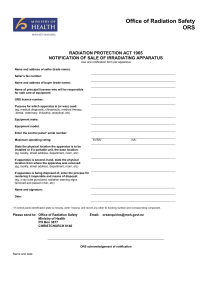Slides 1-3
advertisement
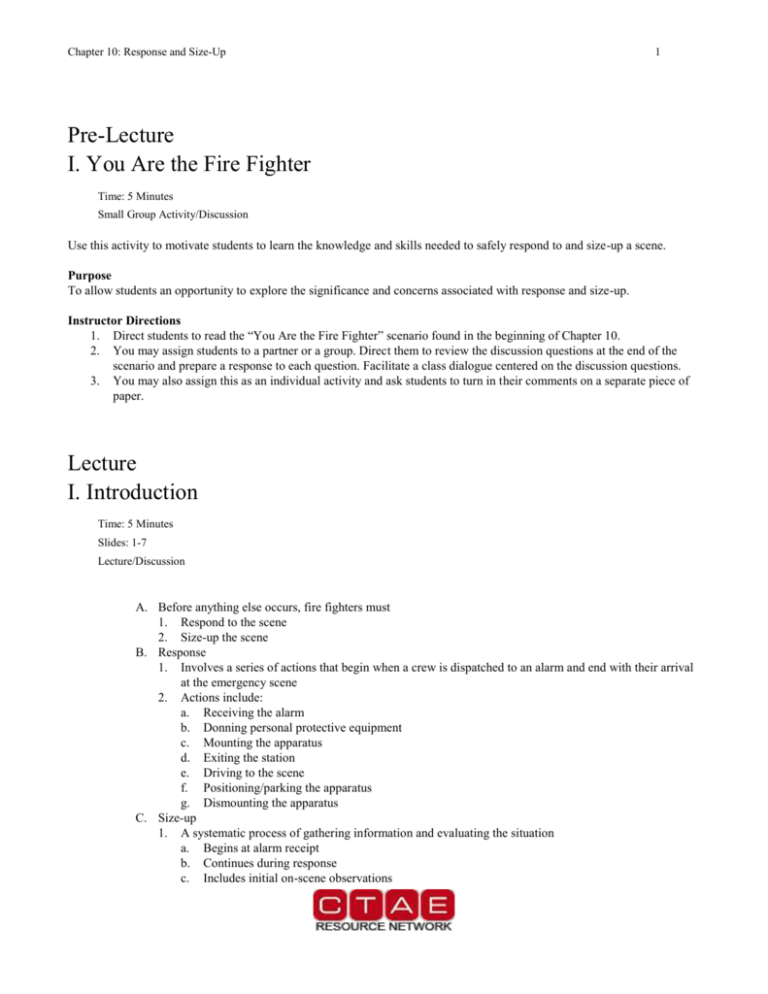
Chapter 10: Response and Size-Up 1 Pre-Lecture I. You Are the Fire Fighter Time: 5 Minutes Small Group Activity/Discussion Use this activity to motivate students to learn the knowledge and skills needed to safely respond to and size-up a scene. Purpose To allow students an opportunity to explore the significance and concerns associated with response and size-up. Instructor Directions 1. Direct students to read the “You Are the Fire Fighter” scenario found in the beginning of Chapter 10. 2. You may assign students to a partner or a group. Direct them to review the discussion questions at the end of the scenario and prepare a response to each question. Facilitate a class dialogue centered on the discussion questions. 3. You may also assign this as an individual activity and ask students to turn in their comments on a separate piece of paper. Lecture I. Introduction Time: 5 Minutes Slides: 1-7 Lecture/Discussion A. Before anything else occurs, fire fighters must 1. Respond to the scene 2. Size-up the scene B. Response 1. Involves a series of actions that begin when a crew is dispatched to an alarm and end with their arrival at the emergency scene 2. Actions include: a. Receiving the alarm b. Donning personal protective equipment c. Mounting the apparatus d. Exiting the station e. Driving to the scene f. Positioning/parking the apparatus g. Dismounting the apparatus C. Size-up 1. A systematic process of gathering information and evaluating the situation a. Begins at alarm receipt b. Continues during response c. Includes initial on-scene observations Chapter 10: Response and Size-Up 2 D. The IC and company officers are ultimately responsible for obtaining the necessary information to manage the emergency incident. 1. Fire fighters are involved in the process of gathering and processing information. 2. Observations made by fire fighters help: a. Anticipate necessary actions. b. Provide company officers with needed information. II. Response Time: 30 Minutes Slides: 8-23 Lecture/Discussion A. Response really begins with preparation for response. 1. Ensure that PPE is complete, ready for use, and in good condition. 2. Ensure that PPE is in designated location. a. Dependent on riding position 3. SCBA a. Conduct daily inspection at beginning of each tour of duty. i. Air supply adequate ii. Face piece clean iii. Personal alert safety system (PASS) operable b. Recheck personal protective equipment and tools thoroughly after returning from each emergency response. B. Alarm Receipt 1. Process begins when an alarm is received at the fire station. 2. Generally, a local or regional communications center dispatches individual units. a. In smaller departments, the dispatcher is often located at the fire station. 3. Most departments have both a primary and a back-up method of transmitting alarms to stations. 4. Radio, telephone, or public address systems are often used to transmit information to fire stations. 5. Use of computer terminals and printers to transmit dispatch messages is increasing. 6. Some fire departments use a system of bells to transmit alarms. a. Volunteer or rural departments may use outdoor sirens or horns to summon fire fighters. b. Most volunteer fire fighters receive dispatch messages over pagers. 7. Dispatch information will include: a. Incident location b. Type of emergency i. Vehicle fire ii. Structure fire iii. Medical call c. Units due to respond 8. Computer-aided dispatch systems often provide additional information. 9. Telecommunicator will provide additional information as it becomes available. a. Information is included in dispatch messages to later-responding units or advice is given to the responding units by radio while en route. b. Additional information can help in planning strategies and preparing themselves for the incident. 10. Response to alarm should be prompt and efficient. a. Walk briskly to the apparatus Chapter 10: Response and Size-Up 3 i. Do not run b. Follow procedures to ensure stoves, faucets, and other station appliances are shut off. c. Wait until apparatus doors are fully open before leaving the station. C. Riding the Apparatus 1. Don PPE before mounting the apparatus. a. Don SCBA after the apparatus stops at the scene, unless SCBA is seat-mounted. 2. All equipment should be properly mounted, stowed, or secured. 3. Be careful mounting apparatus. 4. Steps are high and can be slippery. 5. All fire fighters must be seated in their assigned riding positions with seatbelts and/or harnesses fastened before apparatus can move. a. NFPA 1500 requires all fire fighters to be seated and wearing seatbelts whenever the vehicle is in motion. b. Never unbuckle your seatbelt to don clothing or equipment while en route. 6. Noise produced by sirens and air horns can cause hearing damage. a. Wear hearing protection if provided. b. Hearing protection devices often include radio and intercom capabilities. 7. During transport, limit conversation. a. Listen for instructions and additional information. 8. During the ride to the incident, consider any relevant factors that could affect the situation: a. Time of day or night b. Temperature c. Presence of precipitation or wind d. Location and type of incident D. Emergency Response 1. Fire apparatus driver must always exercise caution when driving to an incident. a. Driving without the proper regard for safety places both fire fighters and the public in danger. b. Never compromise safety for a faster response time. 2. Fire fighters who drive emergency vehicles must have special driver training. a. Many jurisdictions require a special license. b. Most states and provinces allow drivers of emergency vehicles to disregard specific traffic regulations when responding. c. Always consider the actions of other drivers first. 3. Personal vehicles a. Fire fighters who respond in personal vehicles must follow specific laws, regulations, and SOPs. b. Some jurisdictions allow fire fighters to equip their vehicles with warning devices and drive their vehicles as emergency vehicles. c. Other jurisdictions do not grant special status to private vehicles. d. Some areas allow volunteer fire fighters to use colored lights in their private vehicles to request a right of way during an emergency. E. Prohibited Practices 1. Do not ignore departmental SOPs. 2. Do not unfasten your seatbelt. 3. Do not dismount until the vehicle comes to a complete stop. 4. Never stand while riding. 5. Do not hold onto the side of a moving vehicle. 6. Do not ride on the rear step. F. Dismounting a Stopped Apparatus 1. After the vehicle comes to a full stop: a. Check for traffic before opening doors or stepping out of the apparatus. b. Check for any other hazards that might be present: i. Downed power lines ii. Ice or snow Chapter 10: Response and Size-Up 4 iii. Hazardous materials c. Grab a handrail and step down. 2. Be careful when dismounting apparatus. a. Increased weight of PPE and adverse conditions can contribute to slips, strains, and sprains. 3. Use handrails when mounting and dismounting. G. Traffic Safety on the Scene 1. Traffic safety should be a major concern for first arriving units. a. Drivers may not see fire fighters or realize how much room fire fighters need to work safely. 2. Always check for traffic before opening doors and dismounting. 3. Watch out for traffic when working in the street. 4. Follow departmental SOPs to close streets quickly and to block access to areas where operations are being conducted. 5. Highways are very dangerous. a. Cars are approaching at high speeds. b. Use traffic cones or other devices to warn approaching traffic. 6. Wear reflective vests over PPE. III. Arrival at the Incident Scene Time: 20 Minutes Slides: 24-36 Lecture/Discussion A. After arriving, SOPs and the incident management system must guide all actions. 1. Fire fighters always work in assigned teams. a. Companies or crews 2. Teamwork and discipline are essential for safety and efficiency. 3. Command structure plans, coordinates, and directs operations a. Fire fighters responding on an apparatus compromise the crew assigned to that vehicle and take direction from company officer. b. Fire fighter who arrives independent of apparatus must report to IC and is assigned to a company or crew. 4. Freelancing a. Dangerous practice of acting independently of command instruction b. This activity is unacceptable and is not tolerated. c. The safety of each fire fighter at the scene can be compromised by freelancing. 5. Do not respond to an emergency incident unless you have been dispatched. a. Unassigned units and personnel can overload the IC’s ability to manage the incident. B. Personnel Accountability System 1. Used to track every fire fighter at every incident scene a. System maintains an updated list of the fire fighters assigned to each vehicle or crew. b. Tracks each crew’s assignment 2. Fire departments use various types of accountability systems. 3. Many fire departments use personal accountability tags (PATS). a. Tag information may include: i. Name ii. ID number iii. Photograph Chapter 10: Response and Size-Up 5 iv. Medical History v. Medications vi. Allergies b. Fire fighters deposit PATs in a designated location on the vehicle. i. PATs are collected from each vehicle and taken to the command post. ii. Fire fighters responding directly to the scene report to the command post to deposit their PATs and get an assignment. C. Controlling Utilities 1. Controlling utilities is one of the first tasks that must be accomplished. a. Follow departmental SOPs regarding utility control. b. This task is often assigned to a particular company or crew. c. All fire fighters should know how to shut off the building’s utilities. d. If faulty electrical or gas equipment caused the fire, shutting off utilities will help alleviate the problem. e. Gas pipes and electrical wires are in walls that can collapse or be cut with a power tool. f. Prevents electrocutions of fire fighters, gas explosions, and unnecessary water damage. 2. Electrical Service a. The most common instillation is a service drop from above-ground utility wires to the electric meter mounted outside the building. i. Other service installations include: (a) Underground connections (b) Inside meters (c) Multiple services (d) Separate electric meters b. Fire fighters must know what types of electrical services are commonly used in their communities. i. Work with utility companies for specific training. ii. Often a main disconnect switch can be operated to interrupt the power. c. Large systems involving high-voltage equipment should be done by the electric company or a trained individual from the premises. d. The electric company should be called to shut down power from a remote location, like a utility pole. e. Necessary if outside wires are damaged by fire, fire fighters working with ladders or aerial apparatus, or if risk of explosion exists 3. Gas Service a. Natural gas and liquefied propane (LP) are used for heating and cooking. i. Natural gas delivered through underground pipes b. LP gas stored in a tank on the premises or through underground pipes c. A single valve usually controls the natural gas supply to a building. i. Generally located outside the building at the entry point of the gas piping. ii. In older buildings the shut-off valve may be in the basement. iii. The shut-off valve is usually a quarter-turn valve with a locking device. iv. When the handle is in-line with piping, the gas is on. v. When the handle is at a right angle to the pipe, it is closed. vi. A special key or adjustable wrench is needed to turn the handle. d. The valve for an LP gas system is usually located at the storage tank. i. Common type of LP gas valve has a distinctive handle that indicates the proper rotation direction to open or close valve ii. To close, rotate handle to fully closed position. e. Once shut off, the gas must not be reopened until the system has been inspected and readied by a qualified person. 4. Water Service a. Water service to a building can usually be shut off by closing one valve at the entry point. Chapter 10: Response and Size-Up b. 6 In most cases, there is also a valve inside the building, usually in the basement (if there is one), where the water line enters. IV. Size-up Time: 20 Minutes Slides: 37-57 Lecture/Discussion A. Size-up is the process of evaluating an emergency situation to determine what actions need to be taken and what resources are needed to control an emergency. 1. Initial size-up is often conducted by the first-arriving officer who serves as IC until a higher-ranking officer assumes command 2. IC uses size-up to develop initial plans. 3. At a major incident, the size-up process might continue through several stages. 4. Ongoing size-up must consider initial plan effectiveness, fire fighter impact on the problem, and any changing circumstances. 5. Fire fighters must understand: a. How to formulate an operational plan b. How to gather and process information c. How this information can changes plans during the operation 6. Fire fighters are often asked to obtain information or report observations for ongoing size-up. B. Managing Information 1. Information gathered and used in size-up must be continually reassessed to ensure that the action plan is still valid. 2. Size-up is based on two basic categories of information: facts and probabilities. 3. Facts a. Data elements that are accurate and based on prior knowledge, a reliable source of information, or an immediate, on-site observation b. Initial dispatch information will contain facts. i. Location ii. Nature of the situation c. Time of day, temperature, and weather conditions are other factors that can be determined and incorporated into the initial size-up. d. Based on these facts, an officer might have certain expectations about the incident. i. Whether a building is likely to be occupied or unoccupied ii. Whether the occupants are likely to be awake or sleeping iii. Whether traffic will delay the arrival of additional units e. Weather conditions i. Snow and ice will delay the arrival of fire apparatus and create operational problems with equipment. ii. Strong winds can cause rapid extension or spread of a fire to exposed buildings. iii. High heat and humidity will affect fire fighter’s performance and may cause heat casualties. f. Preincident plan i. Contains significant information about a structure ii. Provides details about a building’s construction, layout, contents, special hazards, and fire protection systems Chapter 10: Response and Size-Up 7 Basic facts about a building’s size, layout, construction, and occupancy can be observed upon arrival. i. Officer must consider the size, height, and construction of the building during size-up. ii. Action plan for a single-story, wood-frame dwelling will be different than a steel-frame high-rise tower. h. Age of the building is another fact to consider i. Building and fire safety codes change over time. ii. Balloon-frame construction can provide a path for fire spread. iii. Newer buildings use trusses. i. Plan for rescuing occupants and attacking a fire must consider information about the building layout and stairways j. Special factors that will assist or hinder operations must be identified. i. Bars on windows ii. Firewalls and sprinkler systems k. Building occupancy is critical. i. Office building will have a different set of issues than a school. l. Size of the fire and its location helps determine hose line placement, ventilations sites, and which occupants need to be rescued. i. Direct visual observations give the best information about fire size and location but do not tell the whole story. ii. Flames issuing from only one window suggest that fire is confined to one room, but fire could spread through void spaces. iii. Often the location of fire cannot be determined from the exterior, especially when visibility is obscured by smoke. m. Inside a building, fire fighters can use observations and sensations to work safely. i. A crackling sound may indicate the seat of the fire. ii. Blistering paint could indicate the fire is in the walls. n. The IC needs to gather as much factual information as possible about a fire. i. Company officers report their observations to the IC, who is often in the Command Post. ii. A ventilation company will have a different perspective to report than the company working the hose line. iii. IC may request a reconnaissance report from an officer or fire fighter—this is an inspection and exploration of a specific area. o. Progress reports i. Regular progress reports from companies working in different areas update information. ii. Enables IC to judge if an operational plan is effective 4. Probabilities a. Probabilities are factors that can be reasonably assumed, predicted, or expected to occur but are not necessarily accurate. b. Probabilities use history and experience to make projections about future events. c. Attack plan based on probabilities, predicting where the fire is likely to spread and anticipating potential problems d. IC must quickly identify the probabilities that apply to a given situation. i. For example: An apartment building in the middle of the night will probably have occupants that need to be rescued. e. Convection, conduction, radiation, smoke conditions, and fire conditions enable IC to predict fire extension. f. IC also evaluates the potential for building collapse. i. Construction, location, fire intensity, and length of fire must be considered. g. If possibility of collapse exists, fire fighters must exit building. C. Resources 1. Resources include all of the means that are available to fight a fire or conduct emergency operations at an emergency incident. g. Chapter 10: Response and Size-Up 8 a. b. 2. 3. 4. 5. 6. 7. 8. 9. Resource requirements depend on the size and type of incident. Resource availability depends on the capacity of a fire department to deliver resources to the scene. Basic resources are personnel and apparatus. Firefighting resources are usually defined as the numbers of engine companies, ladder companies, special units, and command officers required to control a particular fire. Resources also include: a. Water supply b. Specialized equipment c. Food and fluids for rehabilitation d. Fuel for apparatus Water supply is a critical resource. a. In area without hydrants, water supply could limit operations. b. Takes time to establish water supply from static source c. Limited amount of water can be delivered by tanker shuttle. Size-up enables the IC to determine what resources will be needed and ensures their availability. Mutual aid agreements a. Fire departments have agreements with surrounding jurisdictions to assist each other if a situation requires more resources than the local community has. Resources must be organized to support efficient emergency operations. a. Fire fighters must be properly organized in companies. Equipment and procedures must be standardized. V. Incident Action Plan Time: 25 Minutes Slides: 58-68 Lecture/Discussion A. The incident action plan outlines the steps needed to control the situation. 1. Based on information gathered during size-up 2. Revised and expanded as additional information is obtained, more resources become available, and incident management structure grows B. Incident action plan should be based on the five basic fireground priorities: 1. Rescue victims. 2. Protect exposures. 3. Confine the fire. 4. Extinguish the fire. 5. Salvage property and overhaul the fire. a. Saving lives is the highest priority. b. Saving property is the remaining priority. c. Priorities are not separate and exclusive. i. Objectives can be addressed simultaneously, and certain activities help achieve more than one objective. ii. For example: A direct attack on a fire will address the objectives of protecting exposures, confining the fire, and extinguishing the fire. d. Priorities guide the IC in making decisions. C. Rescue Chapter 10: Response and Size-Up 1. 2. 9 Always the highest priority Need for rescue depends on many circumstances: a. Type of occupancy b. Time of day c. Degree of risk to the lives of the occupants d. Often, the best way to protect lives is to extinguish the fire quickly. D. Exposure Protection 1. The first priority in protecting property is to keep the fire spreading beyond the area of origin or involvement. a. If the fire is in one room, the objective is to keep it in that room. b. If the fire is in one building, the objective is to keep that fire from spreading to multiple buildings. 2. Sometimes the IC has to look ahead of the fire and identify a place to stop its spread. 3. Keep fire from spreading from structure of origin to an exposure. 4. The IC must sometimes weigh potential losses. 5. If a fire in a vacant building threatens an occupied building, resources will be assigned to protect the occupied building first. E. Confinement 1. After ensuring the fire is not actively extending to exposed areas, the IC will focus on confining it to a specific area. 2. The IC will define a perimeter and plan operations so fire does not expand beyond the area. F. Extinguishment 1. Depending on the size of the fire and risk involved, the IC will mount either an offensive or defensive attack. 2. Offensive attack a. Used with most small fires b. Fire fighters enter the building and seek out the seat of the fire to overpower it with hose lines or extinguishing agent(s). 3. Defensive attack a. Used when the fire is too large or dangerous to extinguish from inside the structure i. Required when the IC determines that the risk to the fire fighters’ lives is excessive b. All fire fighters are ordered out of the building. c. Heavy streams are operated from outside the building. d. Sometimes the fire is allowed to burn itself out. e. Generally involve potentially explosive or hazardous materials G. Salvage and Overhaul 1. Salvage operations are conducted to save property by preventing avoidable property losses. a. Salvage is the removal or protection of property that could be damaged during firefighting or overhaul operations. b. Aimed at reducing smoke and water damage to structure and contents 2. Overhaul is a process conducted to ensure that the fire is completely out before operations are terminated. a. Floors, walls, ceilings, and attic spaces are checked for signs of heat, smoke, or fire. b. Debris is removed and thoroughly doused to reduce potential for rekindle. VI. Summary Time: 5 Minutes Slides: 69-71 Lecture/Discussion Chapter 10: Response and Size-Up 10 A. Preparation for an emergency response begins long before an alarm is received. B. Fire fighters must adhere to safe operating practices when responding to an incident: 1. Remain seated and wearing a seat belt. 2. Use caution in driving to ensure arrival on scene. 3. Be alert for traffic when dismounting on roadways. C. Fire fighters must understand how to size-up an incident. 1. Size-up determines incident action plan. 2. Specific actions taken are based on incident priorities: a. Rescue any victims. b. Protect exposures. c. Confine the fire. d. Extinguish the fire. e. Salvage property and overhaul the fire. VII. Skill Drills Time: 30 Minutes Demonstration/Group Activity Remember to maintain an adequate instructor to student ratio. Purpose Following instructor-facilitated demonstrations, this activity allows students to observe and demonstrate competency in mounting and dismounting an apparatus. Materials Needed 1. An apparatus Instructor Directions 1. Demonstrate each skill, placing emphasis on describing to the students any critical points or procedures. 2. On the basis of the specific skill, assign each student to a partner or team. Provide each partner/team with equipment or materials as needed. 3. Direct students to practice each skill. Closely monitor the practice sessions and provide constructive comments and redirecting. 4. As individual students achieve success, track their skills and conduct skill proficiency exams using the Skill Drill Evaluation Sheets located on the Instructor’s ToolKit CD-ROM. Students failing the exam should be given redirection and an opportunity to practice before being retested. Skills A. Mounting Apparatus (Skill Drill 10-1) B. Dismounting Apparatus (Skill Drill 10-2) Chapter 10: Response and Size-Up 11 Post-Lecture I. Wrap-Up Activities Time: 40 Minutes Small Group Activity/Individual Activity/Discussion A. Fire Fighter in Action This activity is designed to assist the student in gaining a further understanding of scene response and size-up. The activity incorporates both critical thinking and the application of fire fighter knowledge. Purpose This activity allows students an opportunity to analyze a firefighting scenario and develop responses to critical thinking questions. Instructor Directions 1. Direct students to read the “Fire Fighter in Action” scenario located in the Wrap-Up section at the end of Chapter 10. 2. Direct students to read and individually answer the quiz questions at the end of the scenario. Allow approximately 10 minutes for this part of the activity. Facilitate a class review and dialogue of the answers, allowing students to correct responses as needed. Use the answers noted below to assist in building this review. Allow approximately 10 minutes for this part of the activity. 3. You may also assign these as individual activities and ask students to turn in their comments on a separate piece of paper. Answers to Multiple Choice Questions 1. Answer C: Because fire fighters must be ready to react immediately to an alarm, preparations for response should begin even before the alarm is sounded. These preparations include checking personal equipment, ensuring the fire apparatus is ready, and making sure that all equipment carried on the apparatus is ready for use. 2. Answer C: Be careful when mounting and dismounting apparatus. The steps on fire apparatus are often high and can be slippery. When mounting fire apparatus, always have at least one hand firmly grasping a handhold and at least one foot firmly placed on a foot surface. Maintain the one hand and one foot placement until you are seated. Fasten your seatbelt and then don any other required safety equipment for response, such as hearing protection. Eye and face protection are required for seating areas that are not fully enclosed. 3. Answer A: The shut-off valve for a natural gas system is usually a quarter-turn valve with a locking device so it can be secured in the off position. When the handle is in line with the pipe, the valve is open; when the handle is at a right angle to the pipe, the valve is closed. A special key or an adjustable wrench is needed to turn the handle. 4. Answer B: This system of priorities clearly establishes that the highest priority in any emergency situation is saving lives. The remaining priorities involve saving property. Ensuring that the fire does not spread to any exposures is a higher priority than confining the fire within the burning building. After the fire is confined, the next priority is to extinguish it. The final priority is to protect property from additional damage and make sure the fire is completely out. B. Technology Resources This activity requires students to have access to the Internet. This may be accomplished through personal access, employer access, or through a local educational institution. Some community colleges, universities, or adult education centers may have classrooms with Internet capability that will allow for this activity to be completed in class. Check out local access points and encourage students to complete this activity as part of their ongoing reinforcement of firefighting knowledge and skills. Purpose To provide students an opportunity to reinforce chapter material through use of online Internet activities. Instructor Directions Chapter 10: Response and Size-Up 1. 2. 3. 4. 12 Use the Internet and go to www.FireFighter.jbpub.com. Follow the directions on the web site to access the exercises for Chapter 10. Review the chapter activities and take note of desired or correct student responses. As time allows, conduct an in-class review of the Internet activities and provide feedback to students as needed. Be sure to check the web site before assigning these activities, as specific chapter-related activities may change from time to time. II. Lesson Review Time: 15 Minutes Discussion Note: Facilitate the review of this lesson’s major topics using the review questions as direct questions or overhead transparencies. Answers are found throughout this lesson plan. A. B. C. D. E. F. G. H. I. J. K. L. M. N. O. What activities does response encompass? What is size-up and what role does it play in incident operations? What considerations does an emergency vehicle driver need to take in selecting a route and driving speed? Why is it necessary to limit external noise and unnecessary talk during an emergency response? What information should one expect to receive during an alarm dispatch? If time is of the essence, why should fire fighters walk to the apparatus rather than run? What does due regard for the safety of others mean in the context of emergency vehicle operation? What are the provisions of the state’s motor vehicle code in respect to the operation of emergency vehicles? What safety considerations apply to incident operations on a roadway or highway? What is freelancing and what role does it play on the fireground? Why is it necessary to control utilities? What factors should be considered in sizing-up a scene? What are the five basic fireground priorities? Why is exposure control a higher priority than confinement or extinguishment? How are the incident priorities used in fireground decision-making? III. Assignments Time: 5 Minutes Lecture A. Advise students to review materials for a quiz (determine date/time) B. Direct students to read the next chapter in Fundamentals of Fire Fighter Skills as listed in your syllabus (or reading assignment sheet) to prepare for the next class session.

